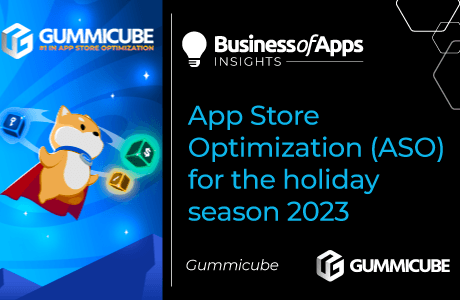ASO encompasses a range of strategies aimed at improving your app’s discoverability in app stores, with the ultimate goal of driving downloads. For some, app marketing is synonymous with paid initiatives, covering everything from app store search ads to paid social media campaigns. While paid marketing can be undoubtedly effective, there’s a treasure trove of potential in organic ASO that serves as the foundation for long-term growth.
In this article, we’ll delve into what organic app marketing is, why it’s essential for growth, and how you can seamlessly integrate it with paid app store marketing strategies.
What is organic app marketing?
Organic App Store Optimization refers to the strategies employed to improve your app’s visibility in app stores without resorting to paid advertising. It consists of optimizing various elements within your app store listing to boost performance. Key components of organic ASO include:
- Keyword optimization: Strategically incorporating relevant keywords in relevant app listing fields. For the iOS App Store, these include the title, subtitle, and keyword bank. For the Google Play Store, these are the app name, short description, and full description.
- Creative assets: Consisting of compelling app icons, screenshots, and preview videos. In both the App Store and Play Store creatives serve as a vehicle for increased conversions, projecting important information in a visually engaging manner.
- User reviews and ratings: Encouraging users to leave positive reviews and high ratings while addressing negative feedback constructively. Engaging through reviews, whether positive or negative, shows existing and lapsed users you care about improving their experience.
- Localization: Adapting your app’s listing to cater to different languages and regions, making it accessible to a broader audience. To truly connect with your target audience in a variety of territories, you can localize app listing elements for the different countries you offer your services
- App updates: Regularly releasing updates with bug fixes, new features, and performance improvements to maintain user engagement. App iterations, whether to improve app functionality or to keep up with seasonal market changes are an effective way of constantly ensuring a fresh experience.
Why organic ASO is essential for app growth
Organic ASO plays a pivotal role in ensuring the long-term success of your mobile app. While paid marketing can provide an initial boost in downloads and visibility, it can quickly turn costly if solely relied upon, as noted in our article covering how much it costs to market an app. organic ASO is a fundamental aspect of your app growth strategy that sets the grounds for success originating from both organic and paid discovery.
Organic app marketing = Sustainable growth
Paid marketing campaigns can be costly, and once you stop investing in them, the influx of new users often dwindles. In contrast, organic ASO provides a foundation for sustainable growth. By optimizing your app listing and fostering positive user experiences, you create a self-perpetuating cycle of increased visibility, continuous organic downloads, and better rankings.
You’ll need to lay a strong foundation consisting of comprehensive keyword research and a thorough competitive analysis, all while adopting a user-centric approach. You should aim to select keywords that accurately reflect your app’s core features and have been historically proven to work for others in your market. By striking this balance can you ensure you are incorporating keywords that accurately represent your app and potentially contribute to growth. For in-depth guidance for kickstarting your organic ASO efforts, you can take a look at our ASO for beginners article.
Once you’ve laid the groundwork for organic growth, you’ll need to stay vigilant and continuously optimize your app listing, adapting to changing trends and user behavior. Anything from seasonal changes to shifting customer habits can warrant a change in your app store listing assets. Consider viewing your app store analytics that provide insights and track the performance of your ASO efforts.
How to combine ASO and paid acquisition
While organic ASO and paid app store marketing can be effective on their own, their true potential is realized when they work in harmony. Here’s how you can combine paid and organic strategies to maximize your app’s visibility and drive sustainable growth.
Keyword synergy
Keyword optimization is a fundamental aspect of both organic ASO and paid app store marketing. The keywords you use for your organic strategy provide the base for future paid initiatives that can later reach an increased number of potential users from your target audience.
For example, if you are a finance app targeting teen investors, “investing for teens” may be a keyword you use. After incorporating it in your app listing and measuring its performance, you can set up a search ads campaign that targets the same type of users you attracted through your organic efforts with that keyword. This further expands your reach and potentially increases your conversions for a term that has historically performed well.
App creative optimization
Your app’s creative assets, including icons, screenshots, and preview videos, play a crucial role in both organic and paid marketing efforts. Optimized creatives help attract, inform, and acquire users in a more dynamic manner when compared to text assets. The first step to leveraging the power of your creatives for both organic and paid initiatives is to focus on optimizing them for your primary listing.
To find out which set of creatives work best, consider running A/B tests through Apple’s Product Page Optimization or Google’s Store Listing Experiments. The results of your tests will provide valuable insight as to which combination of visual assets users respond to best. Whether it’s to give your icon a facelift, include seasonal imagery in screenshots, or update your preview video with new features, mobile app A/B testing is a powerful way to pinpoint exactly how you can optimize creatives backed by user data.
App creative optimization for the Temu app
Source: Gummicube
After identifying a winning combination of creatives you can run search ads and other paid campaigns using your newly optimized app listing. Keep in mind, however, that for Apple Search Ads the creatives appearing in your ad campaign will differ from those in your organic product page. This means you should consider testing images you intend to use in search campaigns that can later be incorporated into your primary listing.
Organic and paid analytics
Both organic ASO and paid app store marketing rely on data and analytics to measure success and make informed decisions. By integrating data from both strategies, you can refine your approach continuously. You can do this manually by analyzing each platform individually and combining the data gathered to make strategic decisions or use an ASO tool that tracks both organic and paid user acquisition, engagement, and conversion metrics.
Conclusion
In the dynamic world of mobile app development, organic ASO is not just a supplementary strategy; it’s a fundamental pillar of app growth. By harnessing the power of organic ASO, you can achieve sustainable growth, enhance credibility, and improve user retention—all at a fraction of the cost of paid marketing campaigns.
However, this doesn’t mean you should ignore paid app store marketing. Instead, combine the strengths of both organic and paid strategies to create a comprehensive approach that amplifies your app’s visibility and drives downloads.
Remember, success in the app industry is not an overnight endeavor; it’s a continuous journey of optimization, user engagement, and adaptation. By embracing both organic ASO and paid app store marketing strategies, you can navigate this journey with confidence, ultimately leading your app to greater heights of success and user satisfaction.
Get started with your organic ASO with the app marketing experts at Gummicube today!













